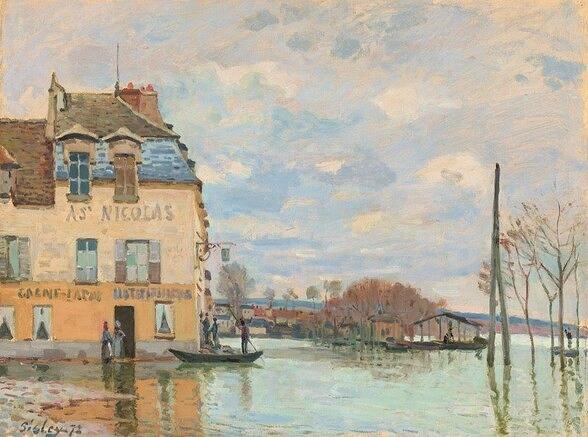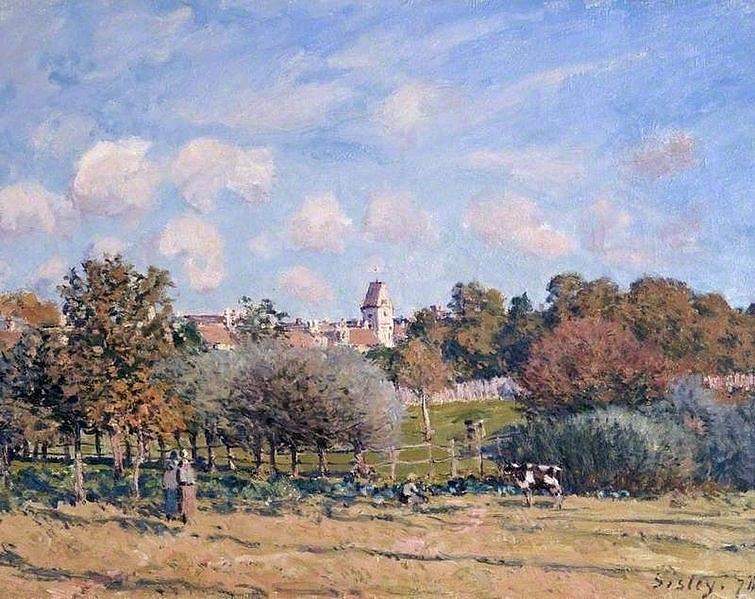Alfred Sisley (1839-1899) was a founding member of the Anonymous Society of Painters, Sculptors, and Engravers in Paris. The group of artists were students at the Ecole des Beaux-Arts, and all painted in “plein air” (outdoors) near Paris at the Forest of Fontainebleau. The original group of artists included Sisley, Monet, Renoir, and Bazille, and they quickly were joined by several others. The group held their first exhibition in Paris in1874. A critic, making fun of the title of Monet’s painting “Impression Sunrise,” wrote sarcastically how impressed he was. From that time on, the group has been known as the Impressionists.
Alfred Sisley is one of the lesser-known Impressionists who became popular after his death. “The Bell Tower at Noisy-le-Roi, Autumn” (1874) (17” x 24”) illustrates Sisley’s style and his talent. The inspiration for the Impressionists was the scientific discovery that sunlight, which illuminates everything, was composed of the colors of the rainbow: purple, blue, green, yellow, orange, and red. All Impressionists began painting in plein air, but Sisley never stopped. He was not a painter of people or the bustling city life of Paris. He was the painter of landscapes and villages up and down the Seine near Paris. He and his family lived in several of these villages his entire life, and local landscapes never failed to inspire him. He painted the villages, fields, forests, and rivers that composed the beauty of the French countryside.
“The Bell Tower at Noisy-le-Roi, Autumn” presents the viewer with a field that has been harvested, a few town residents, and a black and white spotted cow in front of a wooden fence. The fence divides the fields from the town’s bright yellow-green lawn. The sunlight on the field is painted with bright yellow, green, and orange. The deeper furrows in the field are blue, green, and purple. In contrast, the shade under the autumn trees is painted in cool greens and blues.
The orange tile roofs of village houses and the bell tower can be seen beyond the trees. It is a beautiful fall day with a blue sky and scudding white clouds. The complementary colors of orange and blue, green and red, and yellow and purple are distributed throughout the peaceful village scene.
Half the painting is of the sky, the white clouds shadowed underneath with light orange paint. Sisley once said to a critic, “…the sky cannot only be a background…I always begin by painting the sky.” He explained his approach in a letter to his friend Adolphe Tavernier: “The sky is not simply a background; its planes give depth (for the sky has planes, as well as solid ground), and the shapes of clouds give movement to a picture. What is more beautiful indeed than the summer sky, with its wispy clouds idly floating across the blue? What movement and grace! Don’t you agree? They are like waves on the sea; one is uplifted and carried away.”

https://ts.spycommunitymedia.org/files/2022/09/2-White-Hoar-Frost-St-Martin-Autumn-Indian-Summer-1874.jpg
“White Hoar Frost, St. Martin, Autumn, Indian Summer” (1874) (18’’x 21.5’’) depicts another scene of autumn, but it shows the unending variation Sisley found outside his own front door. Autumn is on full display, and the nearby tree has lost all its leaves. At the right, the plants in the field have gone gold and orange, and stacks of logs are ready for winter fires. The furrows are deep and depicted with dark blue and purple in contrast with the yellow and orange of the harvested crops. Sisley’s paintings include a small number of figures, letting the viewer know that the townsfolk are there and active.
The nearer buildings are painted with wide brush strokes and more intense colors to emphasize the solid structures. As the buildings recede into the distance, they are painted with lighter, feathery brush strokes. Sisley employs the technique of aerial perspective: more distant objects are affected by the atmosphere and appear fainter and bluer.
During his lifetime Sisley painted two series of major floods of the Seine at Port Marly. His first-hand record of the floods was unique among the subjects painted by the Impressionists. “The Flood at Port Marly” (1872) (18.25’’ x 24’’) (National Gallery of Art, Washington, D.C.) is one of four paintings he made of the 1872 flood. He captures the swollen river as it rises to the door of the Restaurant a Saint Nicholas. Two women stand on a slip of land in front of the door while a boatman poles his boat in the water. Two others stand around the corner on a set of stairs that have not been submerged. Above them a wrought iron bracket displays the restaurant’s name. At the right a pilon and a few trees bring balance to the foreground of the composition. One figure stands among the trees on an outcropping that is surrounded by water. Another figure rows a boat in front of a shed. More trees and houses recede into the distance.
Sisley details the three-storied structure of the Restaurant: curtains at the windows, shutters both open closed, tall windows with stone cornices on the third floor, and sloped roofs of grey-blue slate and tiles, and multiple chimneys. The painting is composed mainly of the complementary colors blue and orange. Sisley artfully places several horizontal dark blue and purple dashes across the center of the composition, with small touches of the darker colors on the roof of the restaurant and on the foliage of the trees that recede into the background. Sisley was a master of composition, arranging everything to create harmony, balance, and calm even in a dire situation.
Water was another of Sisley’s favorite subjects, and he frequently painted bridges over water and landscapes including rivers. His ability to observe sunlight, movement, and reflections on water was unique. Four years after the 1872 flood, Sisley painted seven pictures of the 1876 flood. At that time, he was able to chronicle the flood from the beginning to the end. As the flood increased, the village of Port Marly was submerged. “Flood at Port Marly” (1876) (19.5’’ x 24’’) depicts the waters of the Seine flowing across the street. Sisley set up his easel around the corner from the Restaurant a Saint Nicholas, the second building on the left. A coach drawn by white horses appears with luggage piled high. Rows of trees, rowers in a boat, and the dark roofed shed can be seen across the street.
Steven Mallarme, French poet and art critic, wrote an article on Impressionism for The Art Monthly review in London shortly after he saw Sisley’s 1876 paintings of the flood: “He captures the fleeing effects of light. He observes a passing cloud and seems to depict it in its flight. The crisp air goes through the canvas, the foliage stirs and shivers.”
Born in Paris to English parents, Sisley was therefore English. However, he lived and worked almost his entire life in France. He visited England only a few times. The last time, in 1897, he married his companion of 31 years, Marie-Louise Adelaide Eugenie Lescouezec. They had a son and a daughter. Sisley applied for French citizenship in1898, but he was refused.
Sisley asked his longtime friend Monet to look after his children when he died. Marie-Louise died in 1899, Sisley three months later. That year, Monet asked George Petit, an art dealer and promoter of Impressionism, to hold an auction of Sisley’s paintings to help support the children. One of “The Flood at Port Marly” paintings sold for 43,000 francs to Count Isaac de Camondowho. Interest in Sisley’s art was thus established.
The well-known art critic, painter, and art theorist Wynford Dewhurst (1864-1941) wrote in one of books on Impressionism: “Rare are the artists who distinguish themselves in every branch of art, lucky the man who excelled in one. An example of the latter is Sisley, ‘pausagiste’ [landscapist] pure and simple, who has left a legacy of some of the most fascinating landscapes ever painted.”
Beverly Hall Smith was a professor of art history for 40 years. Since retiring with her husband Kurt to Chestertown in 2014, she has taught art history classes at WC-ALL. She is also an artist whose work is sometimes in exhibitions at Chestertown RiverArts and she paints sets for the Garfield Center for the Arts.






Write a Letter to the Editor on this Article
We encourage readers to offer their point of view on this article by submitting the following form. Editing is sometimes necessary and is done at the discretion of the editorial staff.